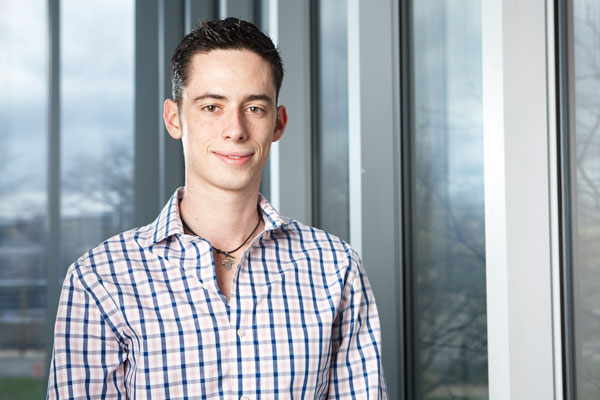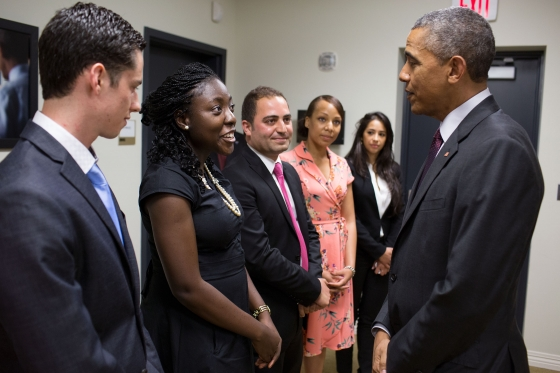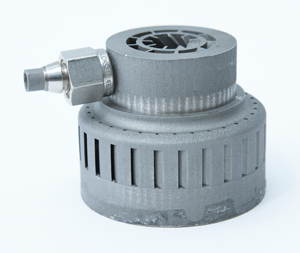Meet our innovator: Felipe Gomez del Campo
Eureka moment: Pumping plasma into jet fuel to boost engine efficiency
Current hometown: Weston, Fla. (native of Mexico City)
Major: Double in mechanical and aerospace engineering
Dream job? Project manager of a new aircraft or new engine program
“Dad, do we have good homeowner’s insurance?” isn’t a typical homework-help question for most parents, but it’s something Felipe Gomez del Campo recalls asking on more than one occasion.
That’s because he spent much of his youth playing with fire … and Bunsen burners, and engines and other combustibles as part of various science projects and just-for-kicks experiments.
Thankfully, as a fifth-generation engineer, Gomez del Campo didn’t get any parental static over his potentially flammable endeavors—in fact, they encouraged him.
“I always kind of took it for granted that my parents let me do all kinds of crazy things in the garage, but if they hadn’t given me that space to tinker, I wouldn’t be here now,” he says.
Gomez del Campo grew up engineering—taking apart garage-sale-fodder electronics provided by friends, family and neighbors just to see how they worked, why they worked, and generating ideas on how to make them work better.
It’s that drive to improve that pushed him into the role of inventor/CEO—the designer and marketer of a product that promises to reduce fuel consumption in jet engines.
The project that grew into Gomez del Campo’s startup FGC Plasma Solutions actually started as a high school science fair entry. He started experimenting with how flames interact with electric fields using a Bunsen burner and a propane tank from the family grill to demonstrate how plasma could help jets use their fuel more efficiently.
The concept won him a fourth-place prize at the science fair, and later a full scholarship to Case Western Reserve. But it was his high school teacher’s comment on the flight home from the fair that really put the invention’s potential into perspective.“He said, ‘Imaging if someday every plane has what you built on it,’ and that kind of inspired me to continue,” he says.
So when he got to campus, Gomez del Campo started scouring Case Western Reserve for resources to refine his invention—essentially, a component that could be fitted to an existing engine, or constructed as part of a new one, that shoots a precise amount of plasma into the fuel. That plasma injection blows the fuel apart into its component molecules, allowing the engine to burn it more efficiently—to the tune of an up-to-10-percent reduction in fuel burned per flight, and a 25-percent reduction in emissions.
He used the university’s invention center think[box] to construct his first prototype, with financing help from the think[box] student project fund. He turned to Blackstone LaunchPad for crucial business advice, the university's Great Lakes Energy Institute for initial seed funds and mentorship, and used the law school's IP Venture Clinic to work on his patent applications.
Gomez del Campo says in a way, the middle of college is kind of an ideal time to launch a startup. "It's the lowest-risk time when you can do this," he says.
And he’s been taking his patent-pending product on the road—meeting with engine manufacturers and combustion research scientists at NASA to pitch the project as well as making the rounds in local and national business competitions. He took the top prize in the university’s Spartan Challenge last year, and took home $100,000 in two separate prizes from the U.S. Department of Energy and Boeing at this year’s Clean Energy Challenge, sponsored by the Clean Energy Trust in Chicago.
Meet the Winners of the 2015 Clean Energy Challenge
Most recently, the entrepreneur and varsity swimmer found his product road show taking him into some very competitive waters swimming with sharks—as in Mark Cuban, Daymond John and Barbara Corcoran of ABC’s Shark Tank, along with one other important listener: President Barack Obama.
During the one-hour panel, which was livestreamed at whitehouse.gov/live, Gomez del Campo and four other young entrepreneurs discussed their startups and the impact U.S. government-led initiatives have had on them. Then, the “sharks” and other successful startup founders—Tony Elumelu of The Tony Elumelu Foundation, Antonio Gracias of Valor Equity Partners and Julie Hanna of Kiva—conducted a five-minute question session with each entrepreneur.
Watch the full event now (Gomez del Campo makes his pitch at 11:35):
(For more information on the event, read the official White House press release.)
It’s been a lot to balance, but Gomez del Campo says in a way, the middle of college is kind of an ideal time to launch a startup. “It’s the lowest-risk time when you can do this,” he says. “If this absolutely fails, and I liquidate the company, I can walk away and have a great story for my resume.”
In the near-term, though, Gomez del Campo plans to make the most of the low-risk environment as a student-entrepreneur. He’d like to parlay the project into his PhD thesis and eventually license the product to an OEM (original equipment manufacturer) to crack into the competitive market.
“Luckily, I’m a good swimmer,” said the junior mechanical and aerospace engineering major—and admitted Shark Tank fan.
He’d also like to share with others some of the good advice and resources he’s been exposed to along the way.
A native of Mexico City, Gomez del Campo moved to the Miami area at the age of 6. Now, after becoming a U.S. citizen just last year, he hopes to set up an “entrepreneurship ecosystem” in Mexico, similar to the one he’s had at Case Western Reserve.
“I always wonder what it would be like if I wasn’t at Case [Western Reserve] and in the U.S., and if I didn’t have the support and resources that I do here,” he said. “I want to make sure people in other countries, like Mexico, have the support they need to have success.”



